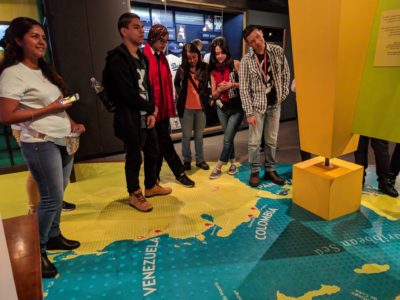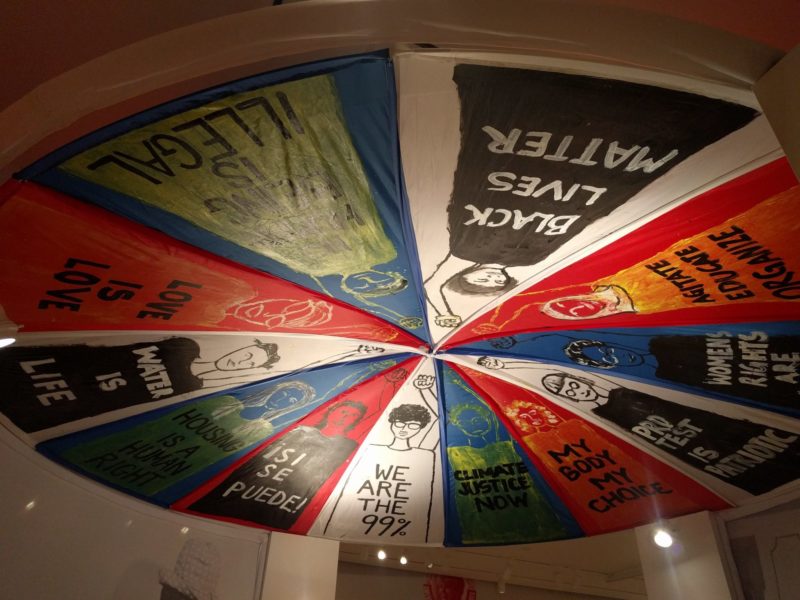Building “The Inclusive Historian’s Handbook”: A working group
19 March 2019 – Will Walker, Modupe Labode, Bob Weible, Sheila Brennan, Bill Bryans, and Kimberly Springle
working group, 2019 annual meeting, digital media, AASLH, projects, methods, collaboration, NCPH, conference, inclusion

Students from the Universidad del Valle (Cali, Colombia) touring the “Viva Baseball” exhibit at the National Baseball Hall of Fame. Photo credit: Will Walker
For the past three years, a group of dedicated authors, editors, and advisory committee members have been working to create The Inclusive Historian’s Handbook, a new digital resource co-sponsored by NCPH and the American Association for State and Local History (AASLH). Although it is not quite ready to share with the public, we are getting closer to a planned rollout in late summer 2019. Throughout the process of developing the Handbook, our team has strived to model open, collaborative, and inclusive practices. The working group we are facilitating at the NCPH annual meeting in Hartford will enable us to continue inviting a wide range of practitioners to contribute to the project and to solicit valuable feedback that will strengthen the final product.
The primary goals of the Handbook are:
• To share a knowledge base that invites more people to engage in history projects.
• To center equity, inclusivity, diversity, and public service.
• To provide concrete examples of how to make history work more relevant.
• To offer accessible windows into the ways public historians work.
The completed Handbook, which will be free and open to all users, will contain 100-150 entries on topics such as “Accessibility,” “Activism,” “Civic Engagement,” “Diversity and Inclusion,” “Heritage Tourism,” “Historic House Museums,” “Historic Preservation,” “Intersectionality,” and “Material Culture.” The entries will be listed alphabetically and clustered using tags, so users can identify related content. Authored by a range of experienced practitioners, each entry will be approximately 2,000 words and include critical reflections, telling examples, and links to additional resources. The first group of approximately thirty entries will be posted publicly in the summer of 2019, with the remainder of the entries posting throughout 2019 and 2020. The Handbook will also feature a “Key Resources” page and an “Introduction” from the editors and advisory committee, which will include suggestions on how to use its content effectively. By making this a freely available digital resource and designing an easily navigable website, our goal is to make the Handbook an accessible resource for the widest range of users possible.

Installation in the “Beyond Suffrage” exhibit, Museum of the City of New York. Photo credit: Will Walker
The Handbook will be an ideal reference source for individuals and groups engaged in historical work in a variety of settings. It will provide community groups, museum professionals, educators, students, scholars, activists, preservationists, archivists, and others with easy-to-find information that is directly applicable to inclusive history practice. The Inclusive Historian’s Handbook will be a vital resource for all professional public historians; at the same time, it will be relevant and accessible for community groups and avocational historians. The overarching goal—of opening up historical practice to the widest possible audience—makes the Handbook an essential text for empowering historians and non-historians alike to make history as well as study it.
The Handbook aligns with NCPH’s goals of building diversity and inclusion across the historical community. Many individual public historians and history organizations state their desire to be more inclusive, diverse, equitable, and service-oriented; in practice, however, we have largely failed to change our practices in ways that would fundamentally open up the field. In many cases, well-intentioned practitioners do not have the tools or knowledge to transform their institutions and practices. The Handbook provides easily accessible information for historians working in multiple contexts.
For our working group in Hartford, discussants received general information about the Handbook and provided access to a select number of completed entries–including “Civic Engagement,” “Diversity and Inclusion,” “Heritage Tourism,” “Historic House Museums,” “Material Culture,” and “U.S. Founders.” The facilitators asked them to read the information as well as several of the entries and respond to the following questions:
• How might you use the Handbook (in your public history practice, teaching, community work, activism, etc.)? How might others you know use the Handbook? Be as specific as possible.
• Which resources will be helpful to you as practitioners in the field? What kind of tools would you like to see that are not currently included? Which specific entries will be most useful to you? Why?
• How can we best market the Handbook to as broad an audience of history practitioners as possible?
A summary of their responses can be found here. We hope you will join us in Hartford on Friday, March 29, from 1:30-3:30 p.m. to contribute your ideas and perspectives to this important project.
~ Will Walker, Modupe Labode, and Bob Weible are the editors of The Inclusive Historian’s Handbook. Sheila Brennan, Bill Bryans, and Kimberly Springle are members of the advisory committee. They will be facilitating the working group “Building The Inclusive Historian’s Handbook.”



